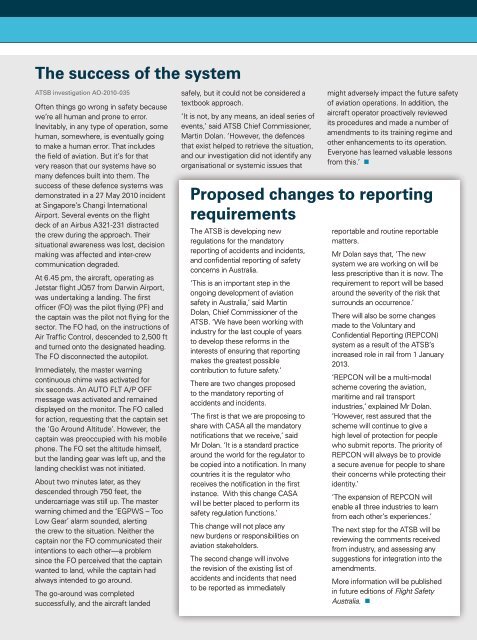jul-aug2012
Create successful ePaper yourself
Turn your PDF publications into a flip-book with our unique Google optimized e-Paper software.
The success of the system<br />
ATSB investigation AO-2010-035<br />
Often things go wrong in safety because<br />
we’re all human and prone to error.<br />
Inevitably, in any type of operation, some<br />
human, somewhere, is eventually going<br />
to make a human error. That includes<br />
the field of aviation. But it’s for that<br />
very reason that our systems have so<br />
many defences built into them. The<br />
success of these defence systems was<br />
demonstrated in a 27 May 2010 incident<br />
at Singapore’s Changi International<br />
Airport. Several events on the flight<br />
deck of an Airbus A321-231 distracted<br />
the crew during the approach. Their<br />
situational awareness was lost, decision<br />
making was affected and inter-crew<br />
communication degraded.<br />
At 6.45 pm, the aircraft, operating as<br />
Jetstar flight JQ57 from Darwin Airport,<br />
was undertaking a landing. The first<br />
officer (FO) was the pilot flying (PF) and<br />
the captain was the pilot not flying for the<br />
sector. The FO had, on the instructions of<br />
Air Traffic Control, descended to 2,500 ft<br />
and turned onto the designated heading.<br />
The FO disconnected the autopilot.<br />
Immediately, the master warning<br />
continuous chime was activated for<br />
six seconds. An AUTO FLT A/P OFF<br />
message was activated and remained<br />
displayed on the monitor. The FO called<br />
for action, requesting that the captain set<br />
the ‘Go Around Altitude’. However, the<br />
captain was preoccupied with his mobile<br />
phone. The FO set the altitude himself,<br />
but the landing gear was left up, and the<br />
landing checklist was not initiated.<br />
About two minutes later, as they<br />
descended through 750 feet, the<br />
undercarriage was still up. The master<br />
warning chimed and the ‘EGPWS – Too<br />
Low Gear’ alarm sounded, alerting<br />
the crew to the situation. Neither the<br />
captain nor the FO communicated their<br />
intentions to each other—a problem<br />
since the FO perceived that the captain<br />
wanted to land, while the captain had<br />
always intended to go around.<br />
The go-around was completed<br />
successfully, and the aircraft landed<br />
safely, but it could not be considered a<br />
textbook approach.<br />
‘It is not, by any means, an ideal series of<br />
events,’ said ATSB Chief Commissioner,<br />
Martin Dolan. ‘However, the defences<br />
that exist helped to retrieve the situation,<br />
and our investigation did not identify any<br />
organisational or systemic issues that<br />
might adversely impact the future safety<br />
of aviation operations. In addition, the<br />
aircraft operator proactively reviewed<br />
its procedures and made a number of<br />
amendments to its training regime and<br />
other enhancements to its operation.<br />
Everyone has learned valuable lessons<br />
from this.’ •<br />
Proposed changes to reporting<br />
requirements<br />
The ATSB is developing new<br />
regulations for the mandatory<br />
reporting of accidents and incidents,<br />
and confidential reporting of safety<br />
concerns in Australia.<br />
‘This is an important step in the<br />
ongoing development of aviation<br />
safety in Australia,’ said Martin<br />
Dolan, Chief Commissioner of the<br />
ATSB. ‘We have been working with<br />
industry for the last couple of years<br />
to develop these reforms in the<br />
interests of ensuring that reporting<br />
makes the greatest possible<br />
contribution to future safety.’<br />
There are two changes proposed<br />
to the mandatory reporting of<br />
accidents and incidents.<br />
‘The first is that we are proposing to<br />
share with CASA all the mandatory<br />
notifications that we receive,’ said<br />
Mr Dolan. ‘It is a standard practice<br />
around the world for the regulator to<br />
be copied into a notification. In many<br />
countries it is the regulator who<br />
receives the notification in the first<br />
instance. With this change CASA<br />
will be better placed to perform its<br />
safety regulation functions.’<br />
This change will not place any<br />
new burdens or responsibilities on<br />
aviation stakeholders.<br />
The second change will involve<br />
the revision of the existing list of<br />
accidents and incidents that need<br />
to be reported as immediately<br />
reportable and routine reportable<br />
matters.<br />
Mr Dolan says that, ‘The new<br />
system we are working on will be<br />
less prescriptive than it is now. The<br />
requirement to report will be based<br />
around the severity of the risk that<br />
surrounds an occurrence.’<br />
There will also be some changes<br />
made to the Voluntary and<br />
Confidential Reporting (REPCON)<br />
system as a result of the ATSB’s<br />
increased role in rail from 1 January<br />
2013.<br />
‘REPCON will be a multi-modal<br />
scheme covering the aviation,<br />
maritime and rail transport<br />
industries,’ explained Mr Dolan.<br />
‘However, rest assured that the<br />
scheme will continue to give a<br />
high level of protection for people<br />
who submit reports. The priority of<br />
REPCON will always be to provide<br />
a secure avenue for people to share<br />
their concerns while protecting their<br />
identity.’<br />
‘The expansion of REPCON will<br />
enable all three industries to learn<br />
from each other’s experiences.’<br />
The next step for the ATSB will be<br />
reviewing the comments received<br />
from industry, and assessing any<br />
suggestions for integration into the<br />
amendments.<br />
More information will be published<br />
in future editions of Flight Safety<br />
Australia. •

















